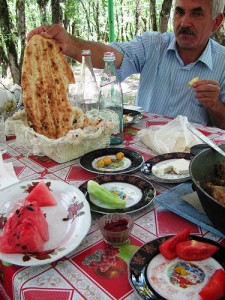- The floating gardens of Bangladesh.
- So, USDA-ARS, what have you done for me lately?
- The story of Ed Toth, the director of New York City’s native plant center on Staten Island. In other news, New York City has a native plant center.
- Not all floods are bad.
- The Consortium discovers FIGS.
- Livestock genetic resources for the poor: The interview. And the PowerPoint. And the Fancy Science.
Nibbles: Cuba gardens, Dual purpose pumpkins, GRIN-Global, Wheat belly, Agroforestry, Zambian malnutrition, Libyan agriculture, Certification
- Visit Cuba with boffins of the University of Washington Botanic Gardens. Well that sounds like fun.
- You liked naked oats? Get a load of naked pumpkins. Comments disabled for Manitoba farmers.
- Psst, wanna genebank data management system? Only slightly used…
- Something else you can blame your beer belly on: wheat.
- Have your forest and eat it too.
- Solving malnutrition in Zambia. I wanna know more about those “improved seed varieties.”
- And about these too for that matter: “…ICARDA is urgently sending to Libya seeds of wheat, barley, legume and forage crops for the 2011-2012 cropping season…” Incidentally, any news about the Agricultural Research Centre in Tripoli?
- Forest certification helps nearby Heritage Sites.
Nibbles: Livestock films, Sea cucumbers, Plant collecting, Nutritional composition, Intensification, Mongolian pastoralists, Low resource tolerance
- More livestock films than you can shake a stick at.
- The Consortium all at sea.
- Road trip! Herbarium specimen collecting in Nepal.
- Call for nutritional composition data on the staples of Papua New Guinea.
- Wanna intensify agriculture in the highlands of East Africa? Here comes the PowerPoint.
- The Tragedy of the Commons averted in Mongolia through collective action.
- A new approach to functional traits? I don’t see the difference myself, but I’ll take their word for it.
Back in Baku
I’ve been travelling so I missed the announcement a couple of days ago on their blog that our friends at CCAFS 1 have a new all-singing, all-dancing platform called the Adaptation and Mitigation Knowledge Network. 2 Which is annoying because the issue of changes in the suitability of the climate for potato cultivation came up in the discussions at the meeting I’m attending here in Baku. And I would quite happily have stolen something else from CCAFS for my presentation. 3 The conference is called “Diversity, characterization and utilization of plant genetic resources for enhanced resilience to climate change” and it was hosted by the Azerbaijan Genetic Resources Institute with support from a number of CGIAR Centres active in the region and FAO, which provided funding for the project of which the meeting is one of the activities.
 There were researchers from pretty much all of the countries of the Central Asia and Caucasus (CAC) region, plus Turkey, Iran, Ukraine and Russia to boot. Many of the presentations brought home to me — and not for the first time — what a tremendously rich part of the world this is for agricultural biodiversity: wild asparagus with stems five meters long; grape varieties sporting bunches almost as long as your arm; strange interspecific wheat hybrids with branched spikes; medicinal plants for every ailment you can think of; wheat landraces phenomenally high in zinc and iron. And that’s just the lunch. Fortunately, the place is also rich in talented researchers busy studying their agrobiodiversity, conserving it, and using it for health, nutrition and food security.
There were researchers from pretty much all of the countries of the Central Asia and Caucasus (CAC) region, plus Turkey, Iran, Ukraine and Russia to boot. Many of the presentations brought home to me — and not for the first time — what a tremendously rich part of the world this is for agricultural biodiversity: wild asparagus with stems five meters long; grape varieties sporting bunches almost as long as your arm; strange interspecific wheat hybrids with branched spikes; medicinal plants for every ailment you can think of; wheat landraces phenomenally high in zinc and iron. And that’s just the lunch. Fortunately, the place is also rich in talented researchers busy studying their agrobiodiversity, conserving it, and using it for health, nutrition and food security.
 Sure, they have problems. Where do they not? But there seems to be a real commitment to getting the job done, enthusiasm even. I was particularly struck by the relatively close linkages between genebanks and breeding programmes in many of the CAC countries. That you certainly don’t see everywhere. I wonder if it’s a legacy of the VIR system. They could do with more collaboration, coordination and sharing of responsibilities at the regional level, not to mention better integration with the rest of the world. But maybe this meeting will help. Anyway, all the presentations, abstracts and final recommendations will be online soon. I’ll post something when they’re up and you can make up your own minds.
Sure, they have problems. Where do they not? But there seems to be a real commitment to getting the job done, enthusiasm even. I was particularly struck by the relatively close linkages between genebanks and breeding programmes in many of the CAC countries. That you certainly don’t see everywhere. I wonder if it’s a legacy of the VIR system. They could do with more collaboration, coordination and sharing of responsibilities at the regional level, not to mention better integration with the rest of the world. But maybe this meeting will help. Anyway, all the presentations, abstracts and final recommendations will be online soon. I’ll post something when they’re up and you can make up your own minds.
To corridor or not to corridor
The fact that distribution change occurs predominantly through spatially restricted, local population processes suggests that the development of ecological networks may be an effective conservation strategy for plant species in the UK (Lawton et al. 2010). An ecological network comprises sites which collectively contain the diversity and area of habitat needed to support species and which have ecological connections between them. The UK is largely made up of semi-natural habitats shaped by human land use, and so consequently, much of the UK’s wildlife is restricted to small fragmented areas of high habitat quality. These can rarely be restored to large unbroken areas of natural habitat. However, making connections between them through wildlife corridors and smaller ‘stepping stone’ sites is a much more feasible option, which would improve species ability to track environmental change through short-range colonisation (Hilty, Lidicker & Merenlender 2006).
…constraints imposed by climatic variability, limited dispersal and low persistence may mean that even habitat corridors through high-quality habitat may not in themselves make range shifts possible. Additionally, corridors for species that show high uncertainty between climate paths under different GCMs are less likely to be effective.
These are from papers in Journal of Ecology and Ecology Letters published within days of each other, though admittedly one dealing with plant species in Britain the other with amphibians in the USA. So what’s a poor boy to do? Stop thinking there’s one solution for everything, I suppose. And get everything into ex situ just in case.